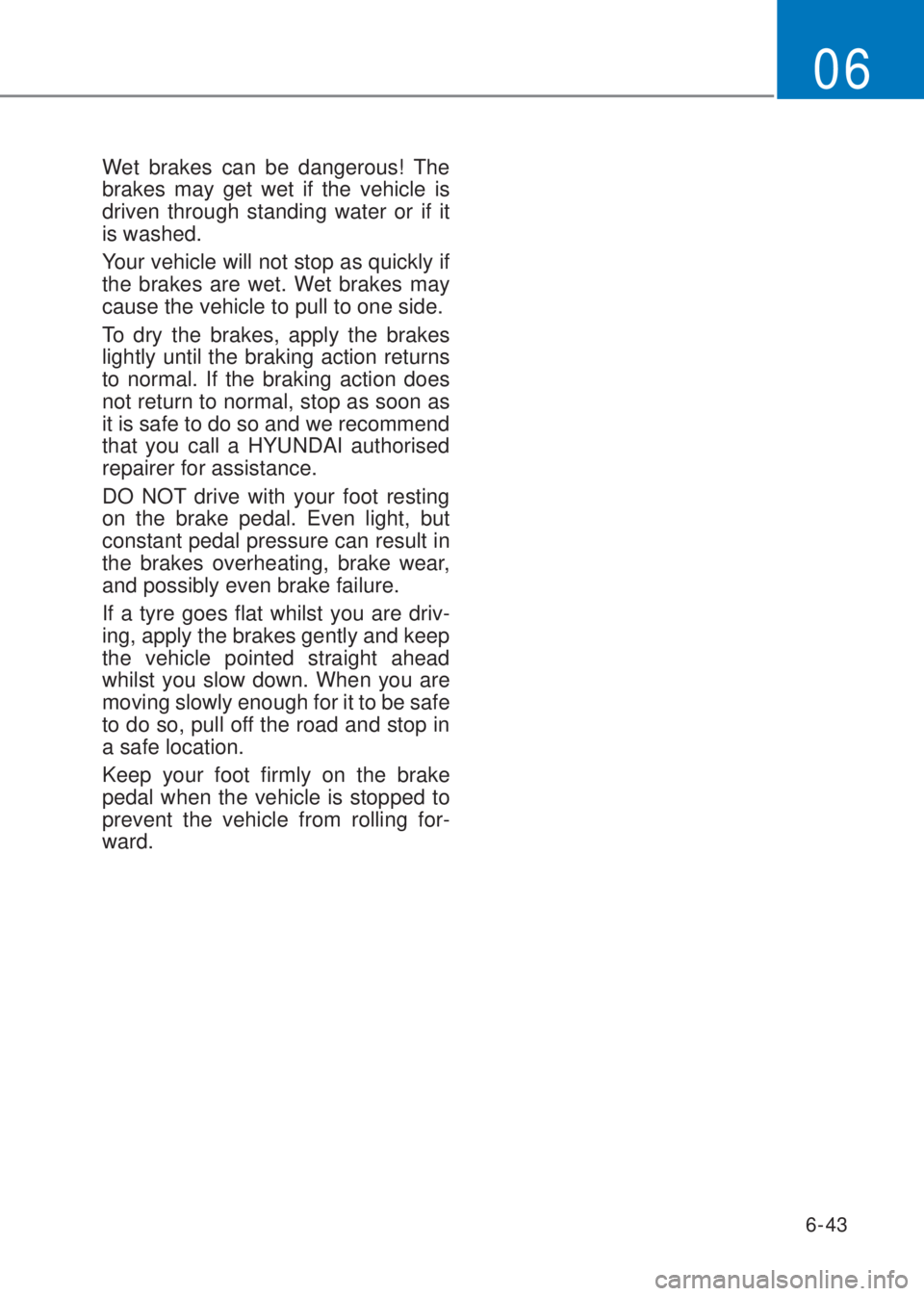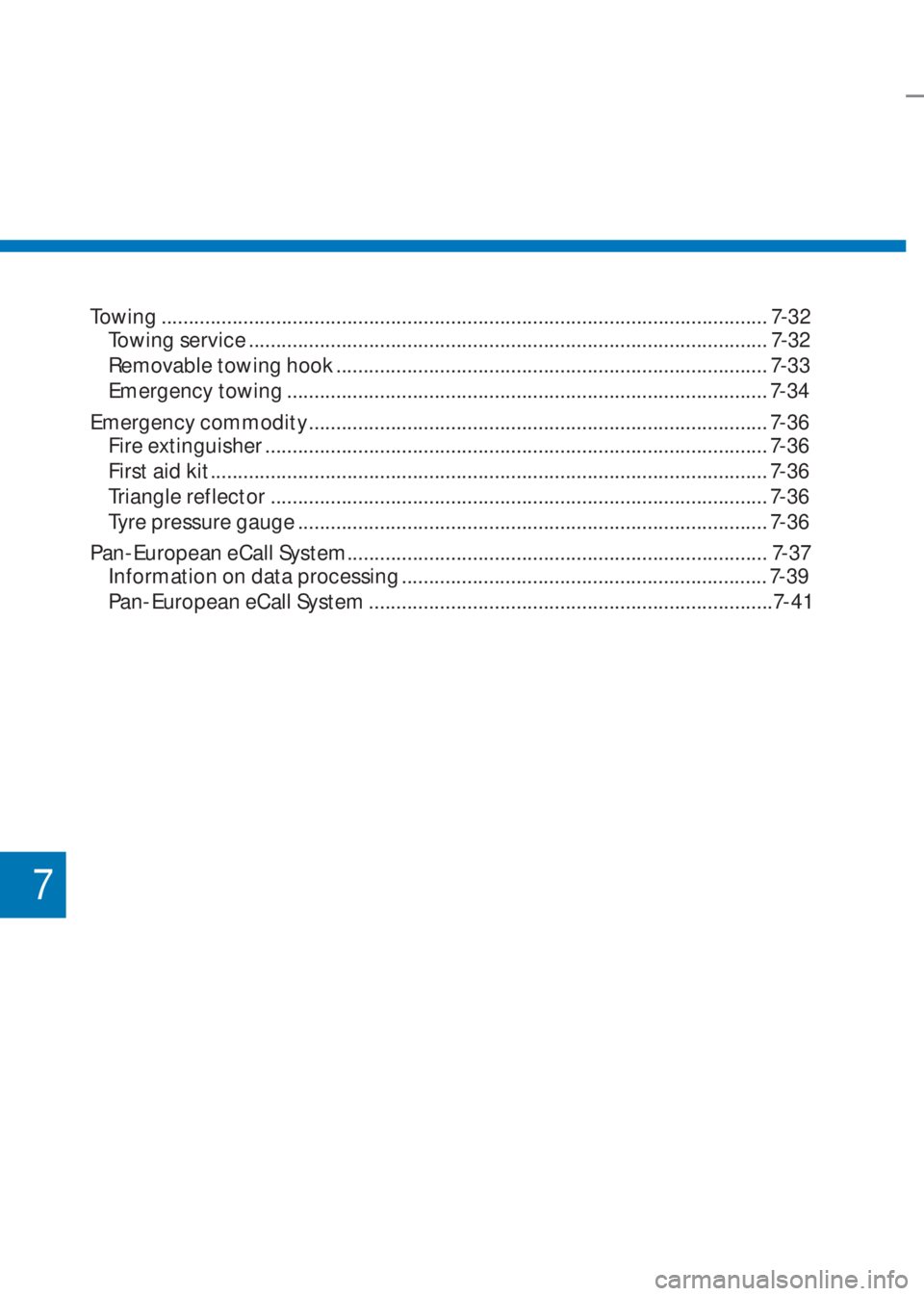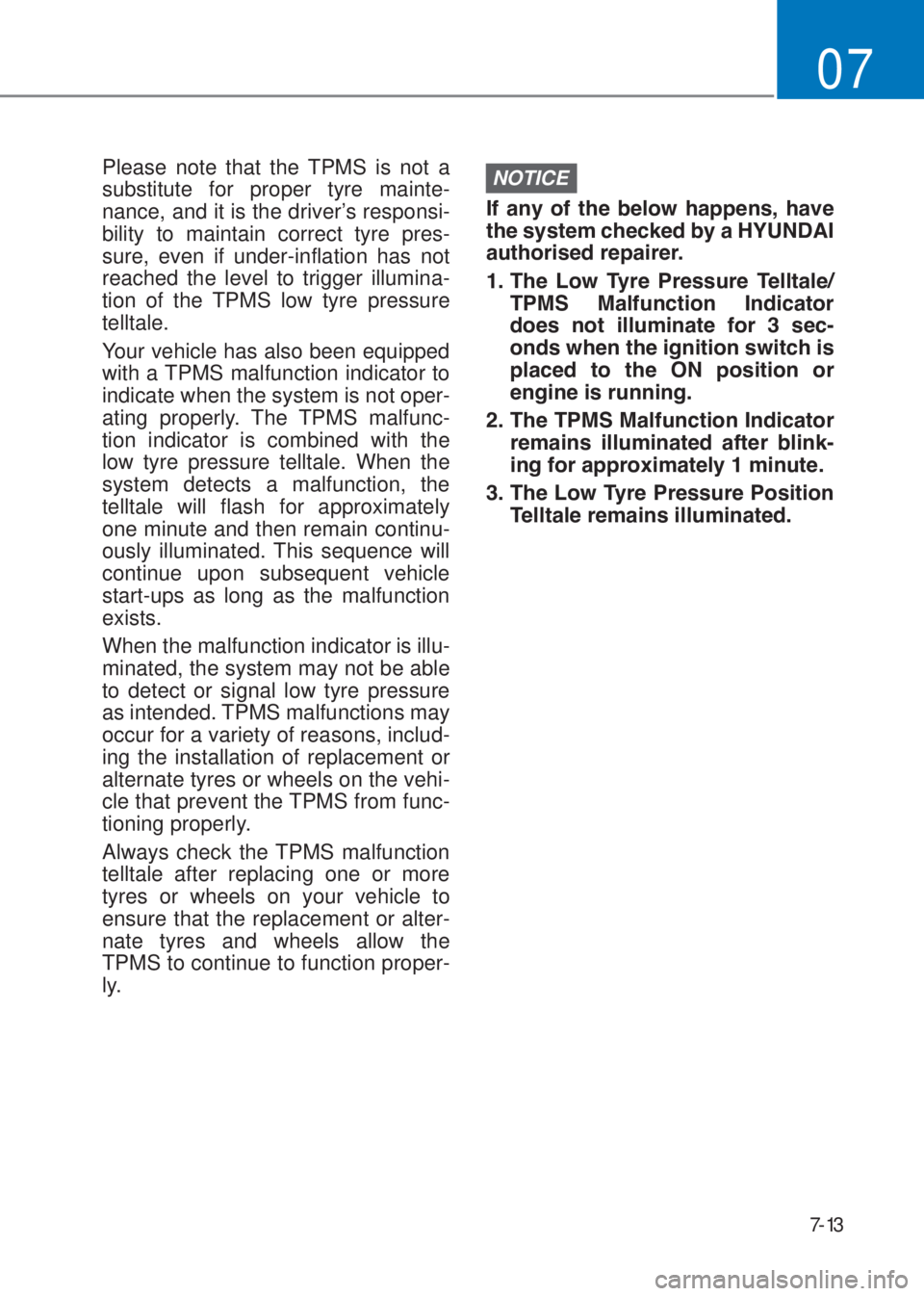Page 299 of 486

6-43
06
Wet brakes can be dangerous! The
brakes may get wet if the vehicle is
driven through standing water or if it
is washed.
Your vehicle will not stop as quickly if
the brakes are wet. Wet brakes may
cause the vehicle to pull to one side.
To dry the brakes, apply the brakes
lightly until the braking action returns
to normal. If the braking action does
not return to normal, stop as soon as
it is safe to do so and we recommend
that you call a HYUNDAI authorised
repairer for assistance.
DO NOT drive with your foot resting
on the brake pedal. Even light, but
constant pedal pressure can result in
the brakes overheating, brake wear,
and possibly even brake failure.
If a tyre goes flat whilst you are driv-
ing, apply the brakes gently and keep
the vehicle pointed straight ahead
whilst you slow down. When you are
moving slowly enough for it to be safe
to do so, pull off the road and stop in
a safe location.
Keep your foot firmly on the brake
pedal when the vehicle is stopped to
prevent the vehicle from rolling for-
ward.
Page 346 of 486

6-90
Whilst driving
Hydroplaning
If the road is wet enough and you are
going fast enough, your vehicle may
have little or no contact with the road
surface and actually ride on the water.
The best advice is SLOW DOWN
when the road is wet.
The risk of hydroplaning increases
as the depth of tyre tread decreas-
es, refer to “Tyre replacement” in
chapter 8.
Driving in flooded areas
Avoid driving through flooded areas
unless you are sure the water is no
higher than the bottom of the wheel
hub. Drive through any water slowly.
Allow adequate stopping distance
because brake performance may be
reduced.
After driving through water, dry the
brakes by gently applying them sev-
eral times whilst the vehicle is moving
slowly.
Highway driving
Tyres
�$�G�M�X�V�W���W�K�H���W�\�U�H���L�Q�I�O�D�W�L�R�Q�����D�V���V�S�H�F�L�I�L�H�G����
Under-inflation may overheat or dam-
age the tyres.
Do not install worn-out or damaged
tyres, which may reduce traction or
fail the braking operation.
i Information
�1ever over-inflate your tyres above the
maximum inflation pressure, as speci-
fied on your tyres.
Fuel, engine coolant and engine
oil
Driving at higher speeds on the high-
way consumes more fuel and is less
efficient than driving at a slower, more
�P�R�G�H�U�D�W�H�� �V�S�H�H�G���� �0�D�L�Q�W�D�L�Q�� �D�� �P�R�G�H�U-
ate speed in order to conserve fuel
when driving on the highway.
�%�H�� �V�X�U�H�� �W�R�� �F�K�H�F�N�� �E�R�W�K�� �W�K�H�� �H�Q�J�L�Q�H��
coolant level and the engine oil before
driving.
Drive belt
A loose or damaged drive belt may
overheat the engine.
Page 353 of 486

Hazard warning flasher ...................................................................................... 7-3
In case of an emergency whilst driving ............................................................ 7-3
If the engine stalls whilst driving .................................................................... 7-3
If the engine stalls at a crossroad or crossing ............................................... 7-3
If you have a flat tyre whilst driving ............................................................... 7-4
If the engine will not start .................................................................................. 7-5
If the engine doesn’t turn over or turns over slowly ..................................... 7-5
If the engine turns over normally but doesn’t start ...................................... 7-5
Jump starting ...................................................................................................... 7-6
If the engine overheats ...................................................................................... 7-9
Tyre Pressure Monitoring System (TPMS) ........................................................7-10
TPMS reset procedure .....................................................................................7-11
Tyre pressure monitoring system .................................................................. 7-12
Low tyre pressure telltale ............................................................................... 7-14
Low tyre pressure position telltale and tyre pressure telltale ..................... 7-14
TPMS (Tyre Pressure Monitoring System) malfunction indicator ............... 7-15
Changing a tyre with TPMS ...........................................................................7-16
If you have a flat tyre (with spare tyre) .............................................................7-18
Jack and tools ................................................................................................7-18
Changing tyres................................................................................................7-19
Jack label ....................................................................................................... 7-23
EC Declaration of conformity for Jack......................................................... 7-24
If you have a flat tyre (with tyre mobility kit) .................................................. 7-25
Introduction ................................................................................................... 7-25
Notes on the safe use of the tyre Mobility Kit ............................................. 7-26
Components of the Tyre Mobility Kit ............................................................7-27
Using the Tyre Mobility Kit ............................................................................ 7-28
Distributing the sealant ................................................................................. 7-30
Checking the tyre inflation pressure ............................................................ 7-30
7. Emergency situations
7
Page 354 of 486

7
Towing ............................................................................................................... 7-32
Towing service ............................................................................................... 7-32
Removable towing hook ............................................................................... 7-33
Emergency towing ........................................................................................ 7-34
Emergency commodity .................................................................................... 7-36
Fire extinguisher ............................................................................................ 7-36
First aid kit ...................................................................................................... 7-36
Triangle reflector ........................................................................................... 7-36
Tyre pressure gauge ...................................................................................... 7-36
Pan-European eCall System............................................................................. 7-37
Information on data processing ................................................................... 7-39
Pan-European eCall System ..........................................................................7-41
Page 362 of 486
7-10
Emergency situations
TYRE PRESSURE
6. If you cannot find the cause of the
overheating, wait until the engine
temperature has returned to nor-
mal. Then, if coolant has been lost,
carefully add coolant to the reser-
voir to bring the fluid level in the
reservoir up to the halfway mark.
7. Proceed with caution, keeping
alert for further signs of overheat-
ing. If overheating happens again,
we recommend that you call a
HYUNDAI authorised repairer for
assistance.
NOTICE
�
Page 363 of 486
7-11
07
The TPMS on this vehicle monitors
and compares the rolling radius and
rotational characteristics of each
wheel and tyre whilst you are driving.
And it checks whether any tyre is sig-
nificantly under-inflated. You should
reset the system by pushing the
TPMS SET button according the
accurate procedure and store the
current tyre pressure.
After that, if one or more tyres are sig-
nificantly under-inflated, the low tyre
pressure indicator illuminates and a
message is shown on the cluster.(if
equipped) Also, if there is a malfunc-
tion with the TPMS, the TPMS mal-
function indicator will illuminate.
�7�3�0�6���U�H�V�H�W���S�U�R�F�H�G�X�U�H
You should reset TPMS in below situ-
ations.
�
Page 364 of 486
7-12
Emergency situations
�Ú If the low tyre pressure indicator
turns on repeat step 3.
When resetting TPMS, the current
tyre pressure is stored as a stan-
dard tyre pressure.
��CAUTION
�
Page 365 of 486

7-13
07
Please note that the TPMS is not a
substitute for proper tyre mainte-
nance, and it is the driver’s responsi-
bility to maintain correct tyre pres-
sure, even if under-inflation has not
reached the level to trigger illumina-
tion of the TPMS low tyre pressure
telltale.
Your vehicle has also been equipped
with a TPMS malfunction indicator to
indicate when the system is not oper-
ating properly. The TPMS malfunc-
tion indicator is combined with the
low tyre pressure telltale. When the
system detects a malfunction, the
telltale will flash for approximately
one minute and then remain continu-
ously illuminated. This sequence will
continue upon subsequent vehicle
start-ups as long as the malfunction
exists.
When the malfunction indicator is illu-
minated, the system may not be able
to detect or signal low tyre pressure
as intended. TPMS malfunctions may
occur for a variety of reasons, includ-
ing the installation of replacement or
alternate tyres or wheels on the vehi-
cle that prevent the TPMS from func-
tioning properly.
Always check the TPMS malfunction
telltale after replacing one or more
tyres or wheels on your vehicle to
ensure that the replacement or alter-
nate tyres and wheels allow the
TPMS to continue to function proper-
ly.NOTICE
�,�I�� �D�Q�\�� �R�I�� �W�K�H�� �E�H�O�R�Z�� �K�D�S�S�H�Q�V���� �K�D�Y�H��
�W�K�H���V�\�V�W�H�P���F�K�H�F�N�H�G���E�\���D���+�<�8�1�'�$�,��
�D�X�W�K�R�U�L�V�H�G���U�H�S�D�L�U�H�U��
�������7�K�H�� �/�R�Z�� �7�\�U�H�� �3�U�H�V�V�X�U�H�� �7�H�O�O�W�D�O�H����
�7�3�0�6�� �0�D�O�I�X�Q�F�W�L�R�Q�� �,�Q�G�L�F�D�W�R�U��
�G�R�H�V�� �Q�R�W�� �L�O�O�X�P�L�Q�D�W�H�� �I�R�U�� ���� �V�H�F-
�R�Q�G�V���Z�K�H�Q���W�K�H���L�J�Q�L�W�L�R�Q���V�Z�L�W�F�K���L�V��
�S�O�D�F�H�G�� �W�R�� �W�K�H�� �2�1�� �S�R�V�L�W�L�R�Q�� �R�U��
�H�Q�J�L�Q�H���L�V���U�X�Q�Q�L�Q�J��
�������7�K�H���7�3�0�6���0�D�O�I�X�Q�F�W�L�R�Q���,�Q�G�L�F�D�W�R�U��
�U�H�P�D�L�Q�V�� �L�O�O�X�P�L�Q�D�W�H�G�� �D�I�W�H�U�� �E�O�L�Q�N-
�L�Q�J���I�R�U���D�S�S�U�R�[�L�P�D�W�H�O�\�������P�L�Q�X�W�H����
�������7�K�H���/�R�Z���7�\�U�H���3�U�H�V�V�X�U�H���3�R�V�L�W�L�R�Q��
�7�H�O�O�W�D�O�H���U�H�P�D�L�Q�V���L�O�O�X�P�L�Q�D�W�H�G��